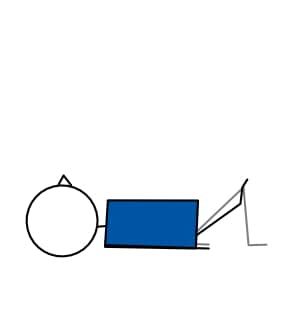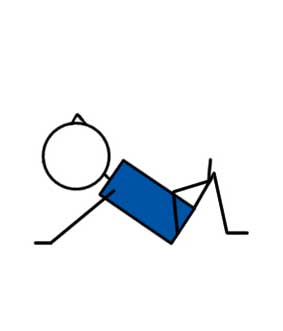
| Category: | Yoga Lesson Planner |
|---|---|
| Sub Category: | Seated & Floor |
| Types: | Animal, Hip Opener, Seated, Seated & Floor, Stretch |
| Anatomy: | Arms & Shoulders, Biceps & Triceps, Core, Hips, Lower Back |
| Chakras: | Sacral Centre |
| Therapy: | Leg Congestion, Poor Posture, Sciatica |
| Drishti: | Up |
| Dosha: | Pitta |
Lie on your back with knees bent, feet on the floor. Cross your right ankle over your left thigh. Hold. Repeat on the other side.
Arms and shoulder stretch. Hip opener.
Bring knee into chest and hold onto thigh.
Knee injury
Click here for lots of FREE downloadable Yoga lesson plans.
Click here for lots of FREE downloadable Pilates lesson plans.
Exploring Supine Pigeon Pose (Eka Pada Rajakapotasana Variation): A Pathway to Deep Hip Release and Relaxation
Supine Pigeon Pose, also known as Eka Pada Rajakapotasana Variation, stands out for its ability to provide deep hip release and relaxation.
This blog post delves into the essence of Supine Pigeon Pose, exploring its benefits, step-by-step practice, and tips for maximising its potential. Whether you are a seasoned yogi or a beginner, this pose can bring significant relief and comfort to your practice, helping you relax and unwind.
Supine Pigeon Pose Overview
It is a versatile pose that can gently open the hips, especially if the Half Pigeon Pose or King Pigeon Pose is too intense. It’s also a great alternative pose for a yoga teacher to give students any hip-opening poses they struggle with.
Supine Pigeon Pose Teaching Directions
Step 1: Lie on your back with your knees bent and feet on the floor.
Step 2: Cross your right ankle over your left thigh (stay here, or if you want to go deeper in the pose, continue to step 3).
Step 3: Lift your left foot, bringing your knee to your chest.
Step 4: Clasp your hands behind your left thigh and gently press your right knee away with your elbow. Lengthen your neck and breathe.
Step 5: Repeat on the other side.
4 Supine Pigeon Pose Modifications
Supine Pigeon II
Lie on your back with knees bent, feet on the floor. Cross your right ankle over your left thigh. Lift your left foot, bringing your knee to your chest. Clasp hands behind your left thigh, gently press your right knee away with your elbow. Lengthen your neck and breathe. Repeat on the other side.
Reverse Pigeon I
The Reverse Pigeon I Pose is a more advanced variation of the pose.
Eye Of The Needle Pose
The Eye Of The Needle Pose is a great modification for beginners. It’s exactly the same as Reverse Pigeon Pose except that it is in a supine position.
Reverse Pigeon Pose Against A Wall
The Reverse Pigeon Pose Against A Wall pose is a great modification and preparation for the Reverse Pigeon pose.
12 Tips for a Successful Supine Pigeon Pose
To enhance your experience of Reverse Pigeon Pose, consider these tips:
Tip 1: Warm-Up
Before attempting the Supine Pigeon Pose, warm your body with a few gentle stretches or movements to prepare the hips and lower back. Poses like Cat-Cow (Marjaryasana-Bitilasana) and Downward-Facing Dog (Adho Mukha Svanasana) can be beneficial.
Tip 2: Restorative Practice
Add the pose into a restorative yoga session, combining it with other gentle, calming poses to promote relaxation and stress relief. Pair it with poses like Child’s Pose (Balasana) and Reclined Bound Angle Pose (Supta Baddha Konasana).
Tip 3: Therapeutic Routine
Use Supine Pigeon Pose as a therapeutic stretch to alleviate sciatic pain and lower back discomfort. Combine it with gentle spinal twists and hamstring stretches for a comprehensive approach to back care.
Tip 4: Morning or Evening Stretch
Practice Reverse Pigeon Pose as part of your morning routine to wake up the hips and prepare for the day ahead. Alternatively, use it in the evening to unwind and release the day’s tension.
Tip 5: Proper Alignment
Lie on your back with your knees bent and feet flat on the floor. Cross your right ankle over your left thigh, just above the knee.
Tip 6: Use Props if Needed
If you can’t reach your thigh, use a yoga strap or towel to hold behind the left thigh and support the stretch.
Tip 7: Flex Your Foot
Keep the right foot flexed to protect the knee joint and ensure proper alignment.
Tip 8: Press Gently
Use your right elbow to gently press the right knee away from your body, deepening the stretch in a controlled manner.
Tip 9: Relax Your Neck and Shoulders
Ensure the neck is long and relaxed, with shoulders resting comfortably on the mat to avoid unnecessary tension.
Tip 10: Breathe Mindfully
Focus on deep, slow breaths, directing the breath into areas of tension to facilitate release and relaxation.
Tip 11: Hold the Pose
Stay in the pose for 5-10 breaths, allowing time for the muscles to stretch and release gradually.
Tip 12: Repeat on Both Sides
Balance your practice by repeating the pose on the opposite side, ensuring equal attention to both hips.
6 Benefits of Supine Pigeon Pose
Practising the Supine Pigeon Pose offers six main benefits for the body and mind:
Benefit 1: Deep Hip Stretch
The pose provides a deep stretch to the hip muscles, helping to release tightness and improve hip flexibility.
Benefit 2: Gluteal Muscle Release
The Supine Pigeon Pose targets the gluteal muscles, particularly the piriformis, which can alleviate sciatic pain and lower back discomfort.
Benefit 3: Lower Back Relief
By stretching the hip and gluteal muscles, this pose helps reduce tension in the lower back, promoting overall spinal health and comfort.
Benefit 4: Improved Circulation
The pose stimulates blood flow to the pelvic region, enhancing circulation and supporting reproductive health.
Benefit 5: Stress Reduction
As a restorative pose, the Supine Pigeon encourages relaxation and stress relief, making it an excellent addition to a calming yoga practice.
Benefit 6: Enhanced Flexibility
Practising this pose can improve overall flexibility, making other yoga poses and daily movements more accessible and comfortable.
Conclusion
Supine Pigeon Pose is a powerful and accessible addition to any yoga practice, offering numerous benefits for both body and mind.
By deeply stretching the hips and gluteal muscles, this pose can alleviate tension, enhance flexibility, and significantly relieve lower back discomfort.
Its restorative nature promotes relaxation and stress reduction, making it an excellent choice for winding down after a vigorous practice or integrating into a gentle, calming routine.
Regular practice of the Supine Pigeon Pose can improve circulation, promote greater hip mobility, and provide a profound sense of balance and well-being.




 Yoga Lesson Planner
Yoga Lesson Planner
 Pilates Lesson Planner
Pilates Lesson Planner








